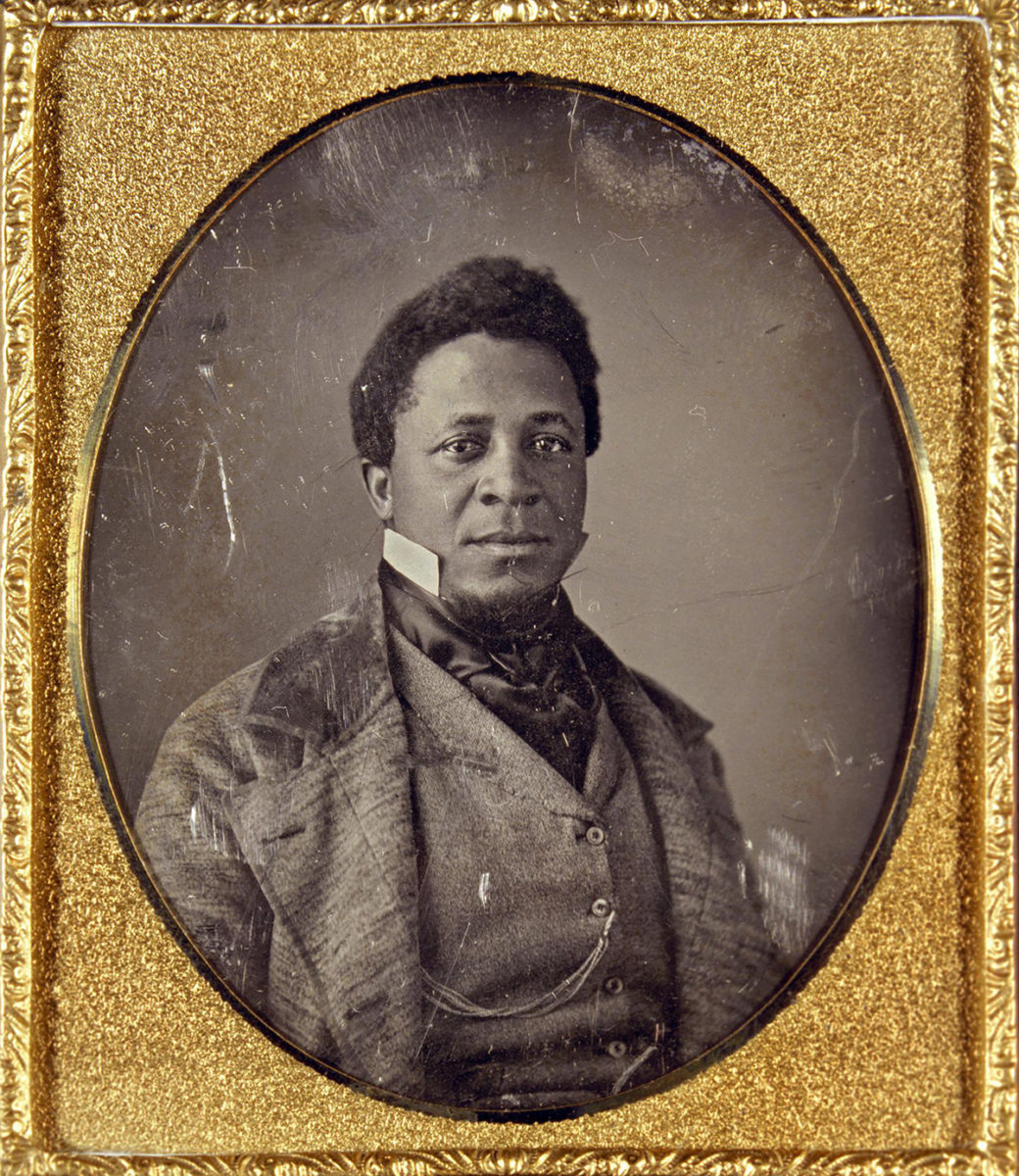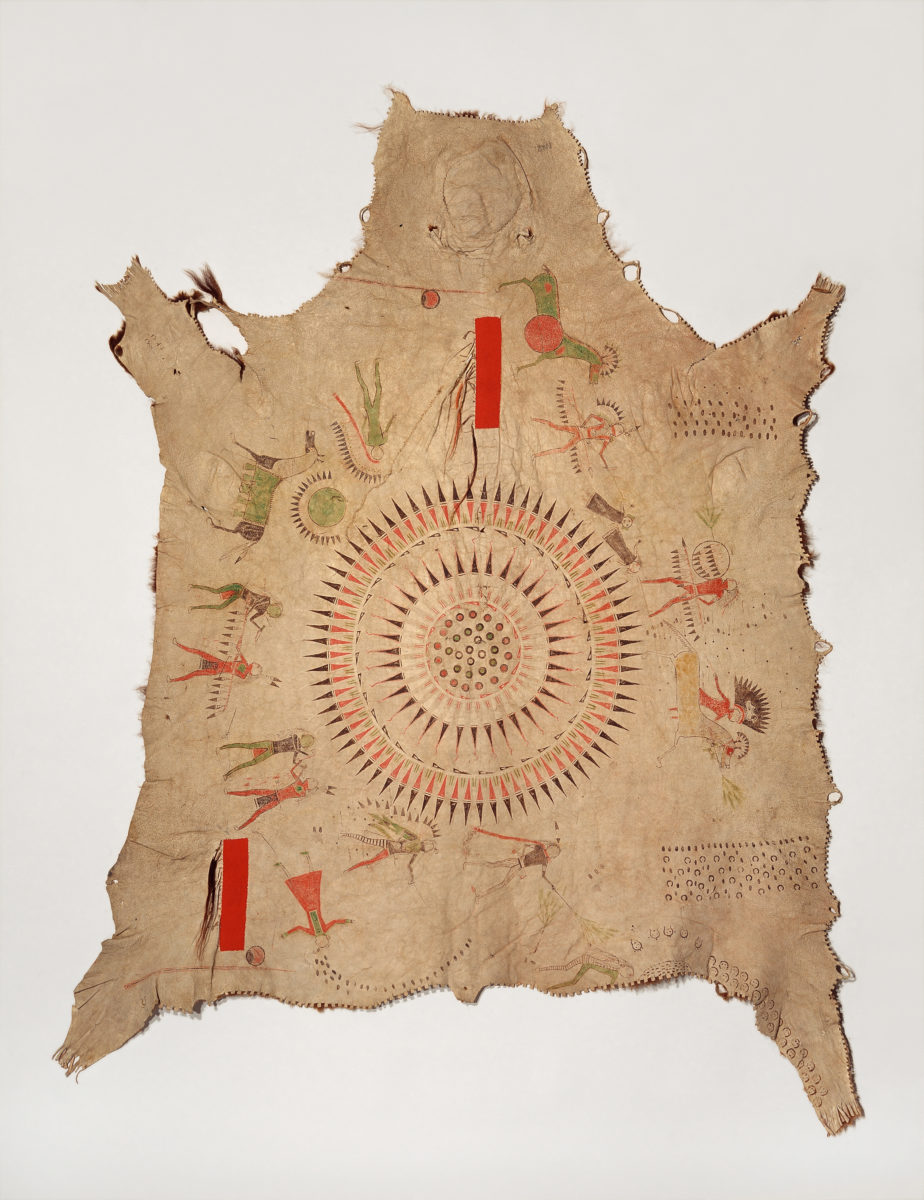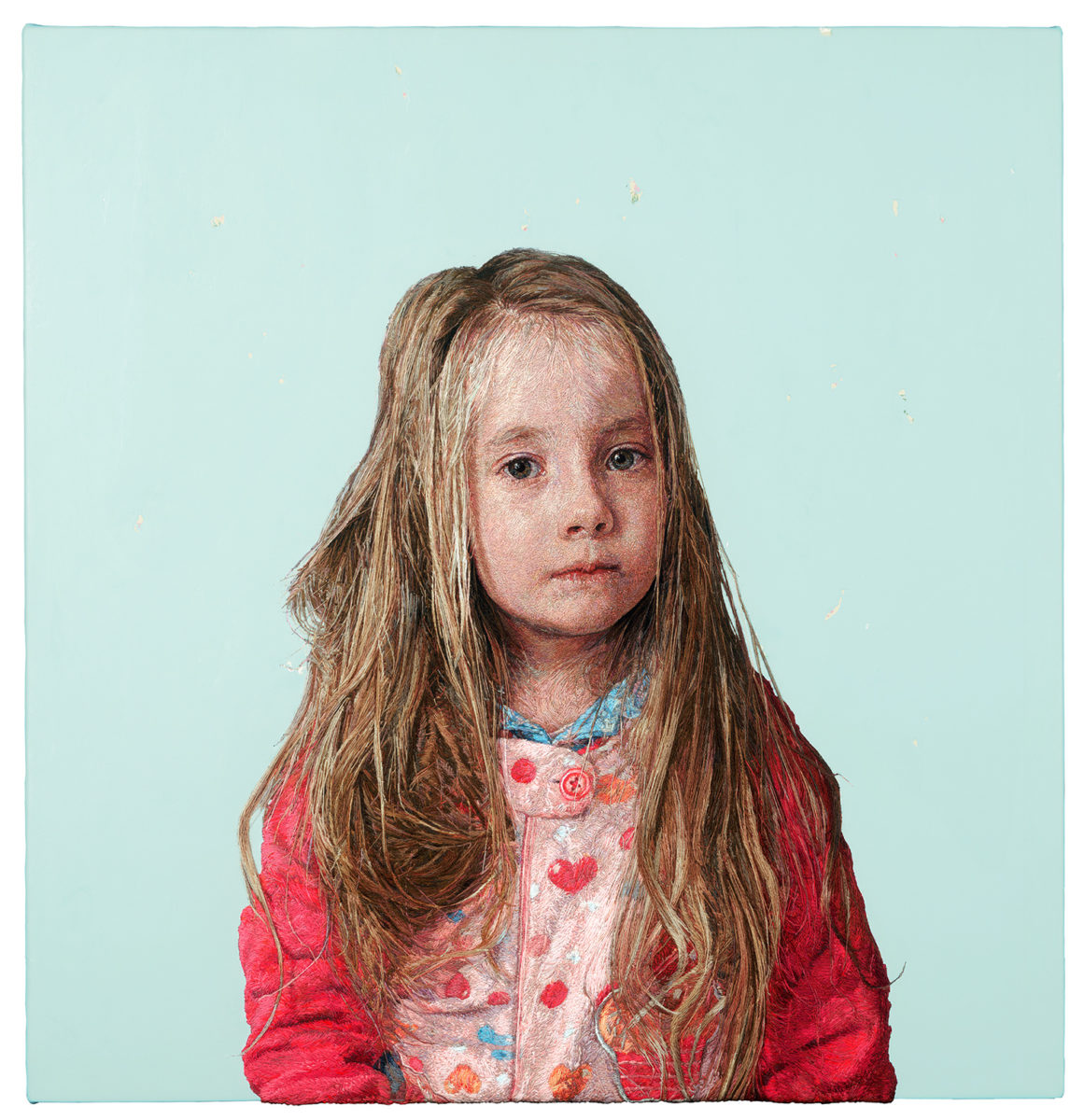How did the confluence region’s natural resources and artistic traditions sustain its makers over time?
Section Overview

Art in Production presents a selection of objects that were chosen specifically for the ways in which they utilized the region’s natural resources and tell stories about creativity and design. By sparking dialogues among disparate materials and industries, from clay and metals to textiles and portraiture, the continuities and changes that have shaped the region’s products over centuries become apparent.
The artwork in this area highlights five material groups: clay, corncob pipes, portraiture, textiles, and metals. For each group you will find selected works of art, looking prompts, and information about each artwork. At the end of this page, you will also find connection activities that apply to multiple subject areas, a looking guide containing images of the artworks that may be used in class settings, relevant standards connections, and a slide presentation with artwork images and questions for discussion.
Art in Production Introductory Video
Art in Production Introductory Text
For more than 1,000 years artists, designers, and craftspeople in the confluence region have created products that sell. For example, the confluence region boasts some of the continent’s richest clay deposits. As a result, clay objects—whether for personal use or sale—have contributed to the identity of this region for centuries.
Many artists and entrepreneurs took advantage of the confluence region’s abundant natural resources to establish and sustain their businesses. These industries followed similar patterns of growth and decline. They began as small-scale enterprises before the American Civil War (1861–1865), expanded through industrialized production, and then often returned to individual, artisanal uses.
In other instances, immigrants to the confluence region drew from their homeland traditions to establish industries that defined their communities. From corncob pipes and zithers to rifles and stained glass, these industries brought their communities national prominence.
Key Terms
Clay
A material found in soil. When mixed with water, it becomes soft and can be shaped. When it dries, it becomes hard, and if you cook it in a fire or very hot oven, often called a kiln, it becomes more like stone.
Terra-cotta
A type of clay that has been fired and is often red in color.
Textile
A type of fabric often made by weaving, knitting, knotting, looping, or braiding yarn or thread together. Textiles can be made from different types of thread, such as cotton, silk, wool, or linen.
Quilt
A cloth that consists of layers of fabric that are held together by stitching and often have a layer of filler, called batting, in between the top and bottom layers to make them soft. Patterns are often made on the surfaces of quilts by stitching and sewing pieces of fabric together in a design.
Embroidery
An art form that uses a needle and thread and intricate stitches to create a design or an image.
Cast Iron
A type of metal that is melted and poured into a shaped mold when it is hot. Once it cools it becomes very hard and can be used for art and household objects such as cooking pans and ovens.
Portrait
A visual representation of a person, often using artistic media such as drawing, painting, sculpture, or photography.
Daguerreotype
An early method of creating photographs in which the image is exposed on a plate made of silver or coated in silver.
Questions for Discussion
- Why are objects that were considered functional in the past now considered art?
- Who determines what is considered valuable? What might influence notions of value? Who or what is left out of these conversations?
- What can we learn about a place or community by looking at the art that is made there?
- How does an object represent changes taking place in the time it was made?
- What relationships can you find between art and the economy?
Selected Works of Art
Follow the links below to view highlighted works of art for this section, explore looking prompts, and learn more about each work of art.
Art in Production Connection Activities
Research and Explore
This section explores artworks created from a variety of materials that were found in the confluence region or brought here by artists who had moved here from other places. Material is an important aspect of art making. Artists are often very thoughtful in their material selections, considering what is available to them, what knowledge or skills they have with that material, and what their goals or intentions are in making their artwork. Using the list below, select one material from this section that you would like to learn more about: clay, wood, silk, cotton, corncobs, iron, or daguerreotype.
Collect details about the material’s properties. Draw a diagram of a sample of the material. Label properties that you have discovered. Add a description of the positive attributes. Brainstorm and write a list of possible ways to use this material.
For younger students
Bring in samples of materials found in this section, such as clay, wood, fabric scraps, corncobs, cast iron, or photographs. Set up a station for students to explore the different materials through touch and observation. Discuss students’ material discoveries as a class or instruct students to write words or draw pictures to describe what they see and feel as they interact with these materials.
Extension
Choose one artwork from this section to reimagine it in a new material. For example, what would the corncob pipes be like if they were made of silk? If made of clay? Draw a picture or write a description of your reimagined object. Give this object a title.
Research
Choose an artist or object you would like to learn more about. What do you wonder about this person or object? What are you curious about? Write a list of questions you have related to this person or object. Let these questions guide you as you research more about this person or work of art. Present your findings to the class.
Create
Susan Bushey was just 11 years old when she stitched Embroidered Sampler. Her embroidered artwork represented the familiarity of home and shared a bit about her own life stories and experiences. Consider your own stories. What is an image or combination of images that would help tell a story from your life? Design your own story square. Use a piece of paper or fabric to draw a design for your story square. Use markers to color in your image. If the materials are available, experiment with gluing pieces of paper or fabric onto your design. Add a decorative or fabric border, if desired.
Extension
Create a collaborative story quilt. Collect each individual student’s square. Lay all the squares onto a large piece of paper, fabric, or cardboard. Work together as a class to design your classroom quilt. Once you have identified a layout, glue, tape, pin, or sew the squares into place. Display the quilt to celebrate the class’s collective stories. Invite students to share their squares and their stories with the class.

Compare and Contrast
Cayce Zavaglia, American, born 1971; Emmylou, 2019; hand embroidery: crewel wool on Belgian linen with acrylic; 29 x 28 1/8 x 1 1/2 inches; Courtesy of the artist and William Shearburn Gallery 2021.17; © Cayce Zavaglia
Susan Bushey, American, 1827–1905; Embroidered Sampler, 1838; linen embroidered with silk; 16 3/8 x 16 5/8 inches; Lent by The Metropolitan Museum of Art, Bequest of Mabel Herbert Harper, 1957 2021.192
Cayce Zavaglia’s embroidered portraits of family members and friends, such as Emmylou, challenge the long-standing perception that needlework is less of a fine art than painting. Unlike the regularity of Susan Bushey’s uniform needlework, Zavaglia practices what she describes as “renegade embroidery” by attempting to replicate painting brushstrokes with stitches. Compare Emmylou with Susan Bushey’s embroidery sample. Look closely at each image using the zoom feature. For each image, write a list of words to describe the details you notice. Compare your two lists. Circle the words that identify similarities between the two works of art. Underline words that identify differences. Share your discoveries with a partner.
Extension for older students
Write an essay comparing the two artworks. In your essay, describe how the two artworks help us to learn about embroidery as an art form and how it has changed over time. Explore additional works from Cayce Zavaglia for reference and inspiration.
Write and Discuss
Portraiture has a long social and artistic history. Consider portraits that you have seen in this resource, and other portraits you may have seen before, such as images on social media, popular culture, billboards, magazines, or other outlets. Explore the question, How can a portrait represent concepts of power or status?
Write a response to this question. Then discuss in a small group. Share the thoughts that came up with your class. Continue the conversation as a whole class as applicable. In the discussion consider additional questions:
- Who defines notions of power or status?
- In what ways can artists or individuals contradict these notions?
- If a portrait is taken by oneself, does that change the way it is perceived by viewers?
- What might be gained by taking a portrait of oneself? What might be lost? What could be potentially problematic in representing another person through portraiture? What could be positive in representing another person through portraiture?
Compare and Contrast
In this section we learned about Thomas Martin Easterly’s photographic portraits. In the section Art at the Confluence, Mató-Tópe described his robe as a self-portrait. Contemporary artist Cayce Zavaglia also creates self-portraits using thread and the technique of embroidery. Compare these varied types of portraits.
What might these portraits have in common? What do you notice that is unique about each portrait?
Create a poster to represent what you have learned about portraits and to share the similarities and differences that you have found among these three examples.
Create
Thinking about the portraits that have been included in this section, and other sections of this resource, design your own self-portrait. What would you like to share about yourself? Consider: Do you want to include your face? Do you want to tell a story from your life? What clothing or accessories do you want to include? What materials do you want to use to make your self-portrait (for example, drawing, painting, fabric, collage, photography, or found materials)?
Photograph
Artists such as Thomas Martin Easterly, Cayce Zavaglia, and Karl Bodmer, who was highlighted in the Art at the Confluence section, created portraits of other individuals. Find a partner. Take turns creating portraits of one another. Before creating the portrait, iinterview your partner to learn more about their interests, hobbies, and experiences. Create a list of questions to ask in your interview that will help you learn more about your partner. Using a smartphone or other available camera, create a photographic portrait of your partner that celebrates who this person is and what you have learned about them. Work together with your partner to identify a pose, background, props, and/or accessories that best represent them.
Alternative
If cameras are not available, draw a portrait of your partner.
Research
Research American history between 1875 and 1900. Using the information gathered, imagine you have traveled back to that time period and embodied the Quilt Top, Pieced Log Cabin just after Anna Jane Parker created it. Write a story from the perspective of the quilt. What is your daily life like? What historical moments or events do you encounter? What would you want students in your school to know about your time as the quilt? Draw on your research to help inform your story.

Standards Connections
The content in this resource has been designed to align with Missouri and Illinois state learning standards and competencies across a variety of grade levels. For each section, we have highlighted a selection of social studies and visual arts standards that have strong connections to the content and activities presented. There are a number of other standards and content areas, such as English language arts, that may also connect with these resource materials. Select the links below for access to key standards and related resources.
-
Missouri Learning Standards
Visual arts
VA:Cn11A.7 Analyze how response to art is influenced by understanding the time and place in which it was created, the available resources, and cultural uses.
VA:Cn11A.6 Analyze how art reflects changing times, traditions, resources, and cultural uses.
VA:Cn11.1.2 Compare and contrast cultural uses of artwork from different times and places.
VA:Cn10A.2 Create works of art about events in home, school, or community life.Social studies
6-8.GEO.1.PC.A Analyze material culture to explain a people’s perspective and use of place.
4.TS.7.A.b Analyze and use artifacts to share information on social studies topics (for example, building structures and materials, works of art representative of cultures, fossils, pottery, tools, clothing, and musical instruments).
3.EG.5.D.a; 4.EG.5.D.a Describe how the people of Missouri are affected by, depend on, adapt to, and change their physical environments in the past and in the present.
6-8.GEO.2.G.C Explain how human-environmental interactions shape people and places. -
Illinois Learning Standards
Visual arts
VA:Cn11.1.1 Understand that people from different places and times have made art for a variety of reasons.
VA:Pr6.1.3 Identify and explain how and where different cultures record and illustrate stories of life and history through art.
VA:Cn11.1.3 Recognize that responses to art change depending on knowledge of the time and place in which it was made.
VA:Cn11.1.7 Analyze how response to art is influenced by understanding the time and place in which it was created, the available resources, and cultural uses.Social studies
SS.EC.3.2 Compare the goods and services that people in the local community produce and those that are produced in other communities
SS.G.2.6-8.LC Explain how humans and their environment affect one another.
SS.G.2.5 Describe how humans have utilized natural resources in the United States.English language arts
Illinois Learning Standards and Instruction


